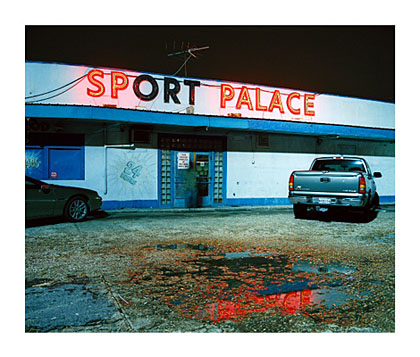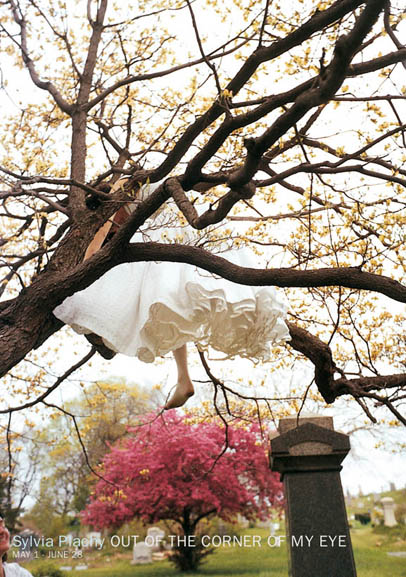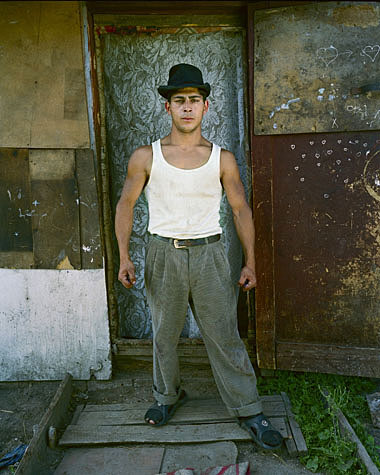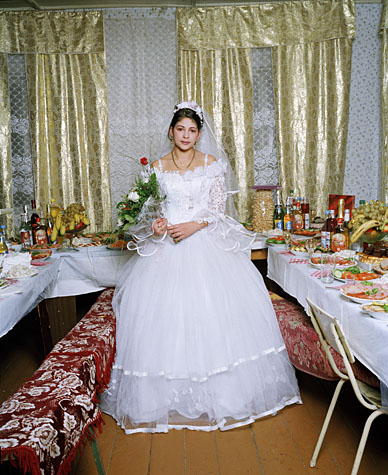This is pretty great, BTW: three galleries showing first-rate contemporary photography, all clustered together on the east side of the river (deepest Siberia to a true Manhattanite ). Actually, four, counting Safe-T-Gallery, which is on the same hallway at 111 but didn't have an opening Thursday night.
Watch your back, Chelsea.

"Sport palace," William Greiner, All rights reserved
At Klompching Gallery Greiner's show, called "Fallen Paradise," depicts New Orleans before Katrina (the storm exiled Greiner, like so many others, from the city in which he had spent most of his life). But Greiner's lost city -- though weirdly attractive -- is no fabled Atlantis. In his pictures, trailers, bars, movie theaters & old industrial buildings seem to doze under neon & hard blue skies. Their gritty realism is both intensified & undermined by Greiner's geometrically precise but not finicky compositions & his lush, saturated colors, which seem to leap off the page. The hyped-up realism is in fact so real it ends up being more about ideas than the actual places Greiner is depicting. This seems right for New Orleans, a place well-known for flaunting style against the odds.

"Culture blast" from "Out of the corner of my eye," Sylvia Plachy, All rights reserved
Plachy's show at Umbrage reflects her new book, Out of the corner of my eye. Included are black-&-white & color pictures from the 60s to the present. Still working steadily, Plachy is a photographer whose career output has already put her among the greats. Andre Kertesz said of her work: "I have never seen the moment sensed and caught on film with more intimacy and humanity. Photographically it is the maximum."

From "BAXT," Andrew Miksys, All rights reserved
BAXT, a Roma (Gypsy) word that translates to English as "fate" or "fortune," is the title of the show by Andrew Miksys at Nelson Hancock. Mainly portraits of young Roma men & women in Lithuania, these pictures navigate between disparate cultures & even eras. The gallery's handout quotes a remarkable piece of criticism by Andrei Codrescu that describes this feat: "...The people who pose for Andrew in these photographs expect something idealized and heroic from him, something that they have been taught years before, is the truly 'artistic,' portrait. Whether they know it or not, their ideas of art were formed by 'socialist-realism.' In seemingly granting them their wish, Andrew does something of a triple somersault: He quotes their ideas back to them without offending them while he makes the multiple ironies accessible to everyone, including his subjects."

"Crying bride," Andrew Miksys, All rights reserved
Itself worth seeing the show for, Miksys's bride (above) has wisely been printed large. A classic wedding shot of a beautiful young woman, it takes on depth as we notice that the bride is crying. Are they tears of joy or is a tragedy unfolding here? Both are possible.
Also included in the show at Hancock is a 2nd photographer, Jonathan Gitelson. His Artist's Books seemed smart & funny, but I was in a big hurry at that point & barely glanced at them.
No comments:
Post a Comment